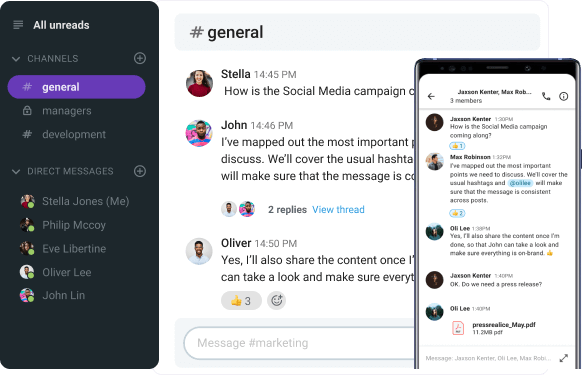Introducing yourself in a professional setting can be nerve-wracking.
After all, your introduction has to:
- Be confident and charming,
- Present the most important information about you, and
- Make you sound like a desirable employee or coworker.
Juggling those goals in high-stress situations can be pretty challenging.
But, if you want to learn how to introduce yourself professionally without losing sight of those objectives, you’re in the right place.
Without further ado, let’s get started.
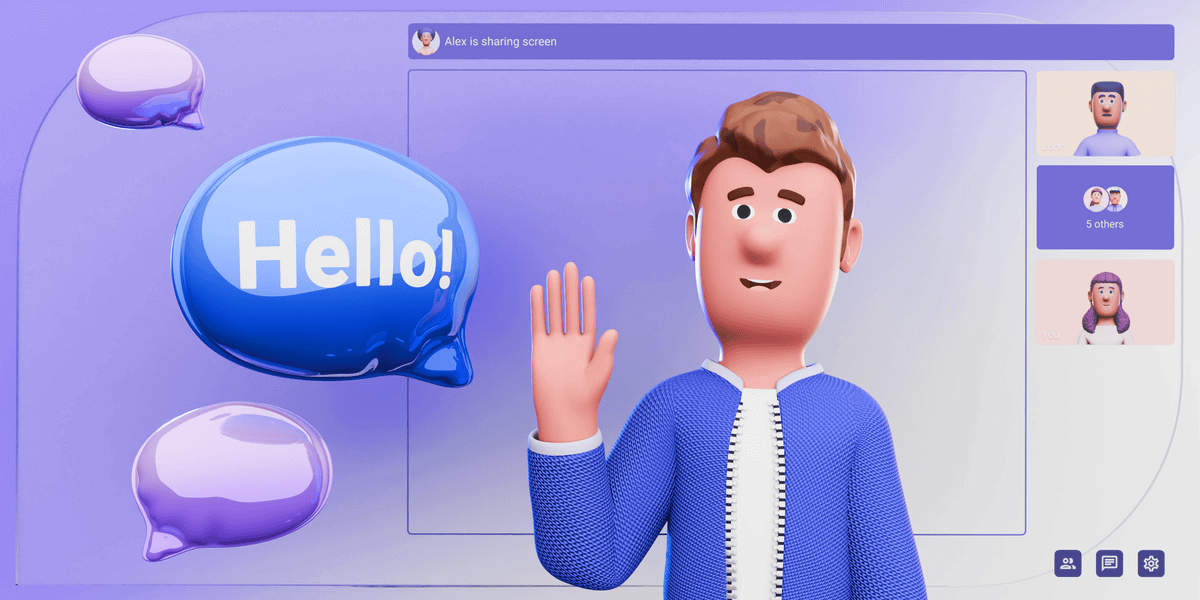
Table of Contents
How to introduce yourself professionally
The best way to introduce yourself in a professional manner is by preparing for the interaction beforehand and maintaining a professional tone throughout the conversation.
After all, you only get one chance to make a good first impression.
Tip #1: Understand why first impressions matter
We’ve established that learning how to introduce yourself professionally and break the ice can be pretty difficult.
This makes sense — most of the time, you’ll be doing it in an unfamiliar or uncomfortable situation. For example, you might be:
- Trying to ace a job interview,
- Reaching out to a new client,
- Attending a networking event, or
- Meeting your coworkers for the first time.
In all of these situations, making a good first impression is crucial, especially when we take into account the primacy effect.
This cognitive bias is to blame for our tendency to find the first information we receive about someone easier to remember than information presented after that point.
Indeed, according to this study on facial first impressions, it takes us a mere tenth of a second to form a judgment about someone.
Similar research conducted by Vanessa Van Edwards, a behavioral investigator, found that we need approximately 7 seconds to make up our minds about something.
Of course, that’s not to say that a subpar self-introduction can have an irreparable effect on your professional relationships.
If you do happen to make a bad impression, you’ll still be able to improve your standing through subsequent positive encounters.
So, don’t worry if you don’t manage to put your best foot forward during that first encounter.
💡 PUMBLE PRO TIP
Job interviews and networking events are only some of the communication situations you’re bound to encounter at work. To learn more, check out this article:
Tip #2: Look appropriate
Whether we like it or not, appearances matter in workplace communication.
If you’re meeting someone face to face — whether it’s in person or over a video call — the first thing they’ll notice about you is the way you look.
So, remember to dress appropriately for the occasion and make sure your clothes are clean and well-ironed.
This will allow you to take advantage of the cognitive bias known as the halo effect, which happens when a positive quality of a person affects our judgment of their other related traits.
In other words, being assertive, confident, and well-groomed can positively influence people’s perceptions of you.
Moreover, you may want to take steps to strategically alter your appearance, depending on the situation.
According to research on first impressions, some people believe they can detect traits such as warmth, trustworthiness, and even power and dominance just by looking at other people’s faces.
How might this influence the way we introduce ourselves professionally?
For instance, in the workplace, people with a more youthful appearance — i.e., a babyface — could be perceived as childlike, naive, and even less competent than their mature-looking peers.
If that’s something you’ve struggled with, you might want to make yourself look more mature by letting your facial hair grow in or applying a certain style of makeup before heading into negotiations.
Alternatively, if you have more severe features and are heading into a friendlier communication situation, you may want to try to soften your appearance.
Tip #3: Pay attention to your body language and other nonverbal cues
Just like your appearance, body language is a part of nonverbal communication — one of 4 major types of communication we use at work and in daily life.
Although nonverbal cues won’t be present if you introduce yourself in writing via a self-introduction email or a team collaboration app, body language is crucial during in-person interactions.
Thus, if you want to know how to introduce yourself professionally, you’ll also need to be mindful of what your body is saying.
Luckily, certain nonverbal cues can significantly improve your first impression, such as:
- Maintaining an open posture (e.g., keeping your back straight and shoulders relaxed),
- Offering a firm — but not forceful — handshake,
- Smiling or generally keeping a pleasant facial expression, and
- Making eye contact without excessive staring.
Interestingly, nonverbal communication also affects the way we speak, through an aspect of communication known as paralinguistics.
For evidence of this, you only need to pay attention to your:
- Vocal tone,
- Pitch,
- Volume, and
- Inflection.
Varying these aspects of your spoken communication can make you come across as a more interesting and engaged speaker. For example, when giving a professional introduction, you might want to speak at a slower pace and louder volume — this gives your words an air of confidence. In contrast, a higher pitch and faster pace could make you sound slightly unsure of your words.
💡 PUMBLE PRO TIP
Body language is an essential factor in virtual meetings, too. And, occasionally, you might have to hop on an online call to introduce yourself in an interview. So, check out our best tips for improving body language during virtual meetings:
Tip #4: Prepare what you’re going to say
A professional introduction should include certain elements, such as:
- Your name and job title,
- A brief description of what you do,
- The reason you’re reaching out,
- Any mutual connections you share with the person you’re talking to, and
- The value you can offer to the person in question (if you’re walking into a job interview).
Though these aren’t the only things you might mention when professionally introducing yourself, they’re a good starting point.
Having an idea of how you’d like to present or describe yourself will make it easier to appear confident by:
- Preventing rambling and oversharing, and
- Maintaining a professional and respectful atmosphere.
Of course, that doesn’t mean you should plan and memorize every word — that could make your introduction seem stiff or even scripted.
Instead, have a general idea of what you’ll talk about while leaving room for improvisation and letting your personality shine.
For example, let’s say you want to figure out how to introduce yourself to a new team over a group meeting.
If your team uses Pumble, the business messaging software, you can list some of the things you’d like to mention about yourself on your “me” page, like Nick did in the example below.
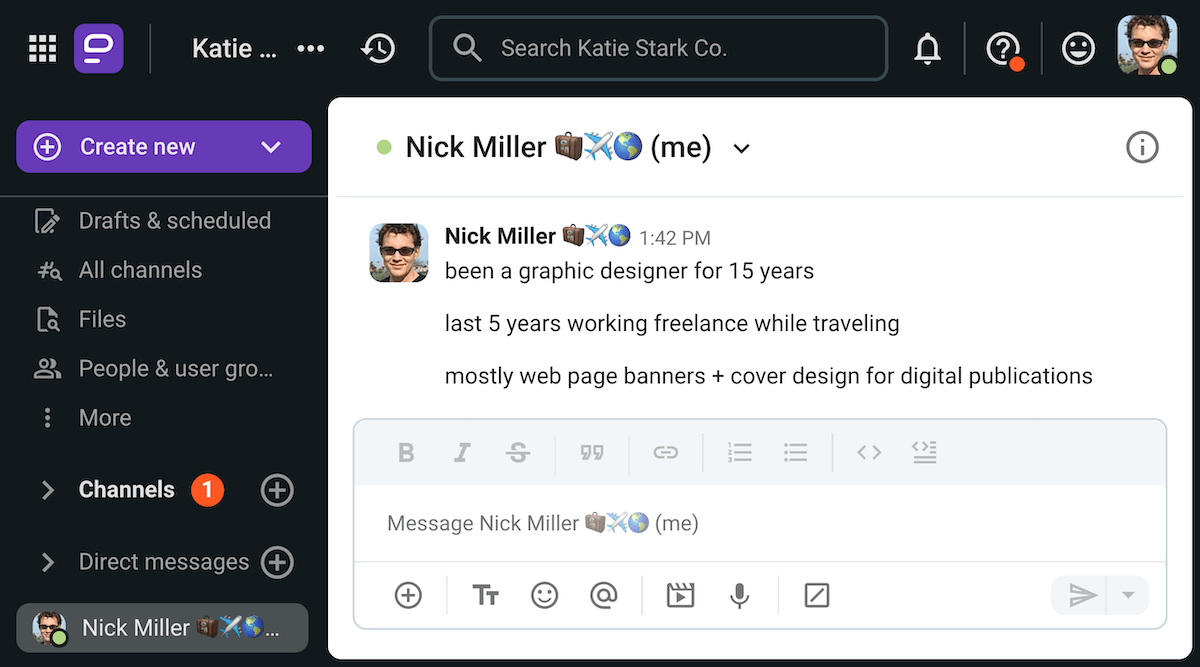
By including additional information in your profile, you won’t have to worry about how to introduce yourself to new colleagues, as you’ll always have an outline waiting for you.
Tip #5: Show interest in the people you’re talking to
Learning how to introduce yourself professionally might make you feel as though you’re being vain or narcissistic.
After all, the point of personal introductions in the business world is to make yourself appear as a great professional and potential collaborator.
However, don’t forget that the ultimate goal of introductions is to spark a conversation.
As such, you’ll have to be invested in the other half of that exchange — namely, the people you’re talking to.
That’s the only way to appear interesting, according to the author of the book How to Win Friends and Influence People, Dale Carnegie:
“To be interesting, be interested.”
— Dale Carnegie
So, after delivering your introduction, be sure to show interest in the other participants of the conversation by:
- Having open body language,
- Listening attentively,
- Keeping interruptions to a minimum,
- Nodding from time to time to express enthusiasm,
- Asking questions to make sure you understand and show your engagement with the topic, and
- Showing appreciation (by saying things like “It was a pleasure meeting you. Thank you for your time and your invaluable advice. Looking forward to talking to you again soon.”)
Below, we can see how a newly instated manager might show her appreciation for her team after their first group meeting:
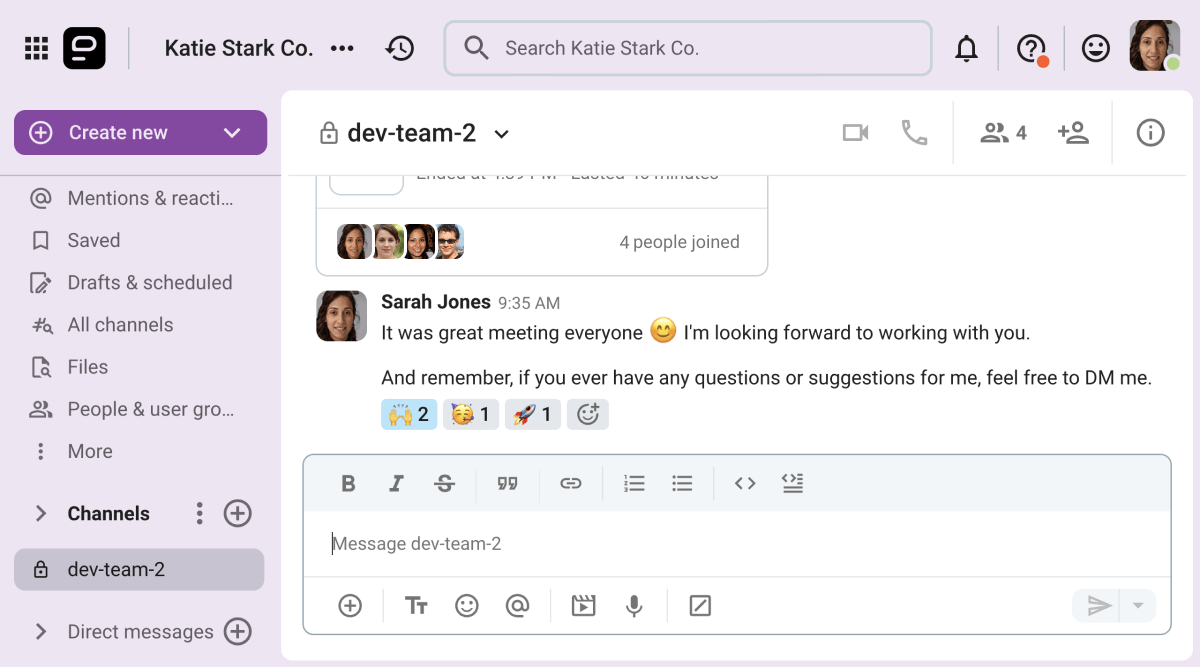
Even though this tip doesn’t seem applicable in some contexts — like job interviews, for one — showing interest and asking questions is always the way to go if you want to stand out in a professional environment.
💡 PUMBLE PRO TIP
One of the most effective ways to give your conversation partner your undivided attention is through active listening. To learn how to apply this practice in a professional setting, check out this resource:
Phrases to use when introducing yourself professionally
Now that you know how to introduce yourself professionally in theory, it’s time to go over some specific phrases you can use.
When in doubt, keep it simple with these go-to lines of self-introduction for interviews and other first-time meetings:
“Hi, my name is __, and I’m a [job title] at [company].”
“Let me introduce myself, I’m…”
“Nice to meet you, my name is…”
“I don’t think we’ve met before — I’m…”
When describing what you do, you can stick to the best introduction lines about yourself we’ve mentioned above. For example, “I’m [job title] at [company],” should do the trick.
Alternatively, you can say:
“I work in [field/industry]…”
“Currently, my job is to…”
“I work as a [job title], and my role is to…”
“My job is [job title], which essentially means …”
“I work as a [job title]. I’m responsible for…”
“I’m self-employed/freelancer in [industry].”
“I work with [person].”
Then, you can let them know why you’re there and/or what they can expect from you:
“I’m here to…”
“I’m reaching out because…”
“For the next [amount of time], I’m going to…”
“My purpose today is…”
“I’d love to…”
Let’s see how that looks all together in different scenarios.
How to introduce yourself in an interview
Introducing yourself in an interview can be daunting, but it’s crucial for establishing your personal brand.
To simplify the process, try following these steps:
- Start with a statement that introduces your name and job title.
- Share relevant details about your background, such as education, past projects, employers, or accomplishments.
- Express enthusiasm for what’s ahead.
Let’s see those tips in action.
An example of how to introduce yourself in an interview
Your self-introduction for interviews doesn’t have to be complicated to be effective. To give you an idea of how to introduce yourself in an interview, check out the following example:
“Hi! My name is Samantha Johnson.
I’ve been working as a social media manager for the past 9 years, and I’m excited about the opportunity to join your Marketing team!
After successfully managing many social media accounts, including X and Y, I’d love to use my skills to help you build your social media presence, increase brand awareness, and improve customer communication.”
Since she’s at a job interview, Samantha wouldn’t need to clarify her job title. After all, hiring managers should be familiar with the position and what it entails.
Knowing that, she can proceed to:
- Express her enthusiasm to work for their company,
- Mention the relevant work experience and achievements, and
- Describe how she’s going to provide value to the company.
All of this makes an excellent self-introduction for a job interview.
How to introduce yourself in an email
Written introductions tend to look a bit different than verbal ones, so here’s how to introduce yourself professionally via email:
- Use a catchy subject line that also contains your name and position.
- Research the company culture or the personality of the recipient of your message so you can adjust your tone and writing style accordingly.
- Show your value by referencing your strongest skills and how they helped you excel in previous roles (if you’re writing to apply for a job).
- Express enthusiasm by sharing what you hope will come from the email in question.
- Promptly respond to replies and ask questions to elicit follow-up emails.
Don’t worry — even after including all these details, you’ll still keep your introduction short but informative.
An example of how to introduce yourself professionally via email
So, what exactly would an attention-grabbing self-introduction email look like?
To answer that question, let’s look at the example below.
“Email Subject: Experienced Data Analyst with a passion for data analysis processes
Email body:
Dear Andrew,
I am a data analyst with over 6 years of experience in data analysis and visualization. I’m excited to express my interest in the Data Analyst role at your company.
Your company’s goal to improve data-driven decision-making models aligns with my passion for the analysis and research fields, and I believe I can contribute to your organization’s future success.
My experience and skills will enable me to provide valuable insights and drive decision making for your organization. I am enthusiastic about the opportunity to work with your team and help elevate your organization’s procedures.
Let me know if we can schedule a call or meeting to discuss this further.
Thank you for considering my application.
I look forward to hearing from you soon.
Kind regards,
Anne Marie Donaldson”
Not only does this introduction email have a catchy subject line, but it also:
- Shows how the sender’s goals align with the company’s mission,
- Highlights how the sender’s skills may benefit the company, and
- Doesn’t contain fluff and unnecessary details.
How to introduce yourself professionally in a letter
A well-crafted introduction letter can show your accomplishments or business in the best light.
If you’re trying to figure out how to introduce yourself to a client or job prospect, just be sure to include sufficient background information about yourself by:
- Starting with a formal greeting and elaborating on the purpose of the letter.
- Providing additional information about yourself and highlighting key skills, qualifications, and accomplishments. If possible, also mention any mutual acquaintances.
- Thanking the recipient for their consideration and providing your contact details after the sign-off.
An example of how to introduce yourself in a letter
Self-introduction letters can bolster your networking efforts and help you form connections with organizations, colleagues, and recruiters.
You can use the example below for inspiration if you’re trying to figure out how to introduce yourself in a letter.
“Dear Jordan,
I hope this letter finds you well.
I came across your profile while searching for accomplished professionals in the online marketing domain and was impressed by your experience and achievements.
As a fellow professional in the marketing industry, I believe it’s important to connect with like-minded individuals to foster mutual growth. I’m particularly interested in social media marketing, and I think your advice could help me push my efforts forward.
I would appreciate the opportunity to arrange a brief call to discuss our shared interests and potential collaborations.
Please let me know a time that works for you.
Thank you for considering my request.
Best regards,
Tom Roberts
tomroberts@email.com
555-555”
How to introduce yourself to new colleagues at work
Most of the self-introduction examples we’ve shared so far can come across as a bit too reserved when you deliver them to someone you’ll be working with closely.
So, if you want to know how to introduce yourself to new colleagues, you should:
- Go in for a handshake and keep your body language open and relaxed,
- Focus on the positives when talking about your first few weeks on the job,
- Ask questions and show genuine interest in your new colleague’s work and opinions, and, above all,
- Keep your messages short, particularly if your workplace uses a business messaging app for professional correspondence.
An example of how to introduce yourself to new colleagues
If you’re trying to figure out how to introduce yourself to a new team or coworker, remember to keep your introduction short and sweet.
Your message should be:
- Short and friendly, while
- Conveying genuine happiness about having the opportunity to work with the new coworker(s) you’re talking to.
That can be communicated with a simple message, as shown in the example below.
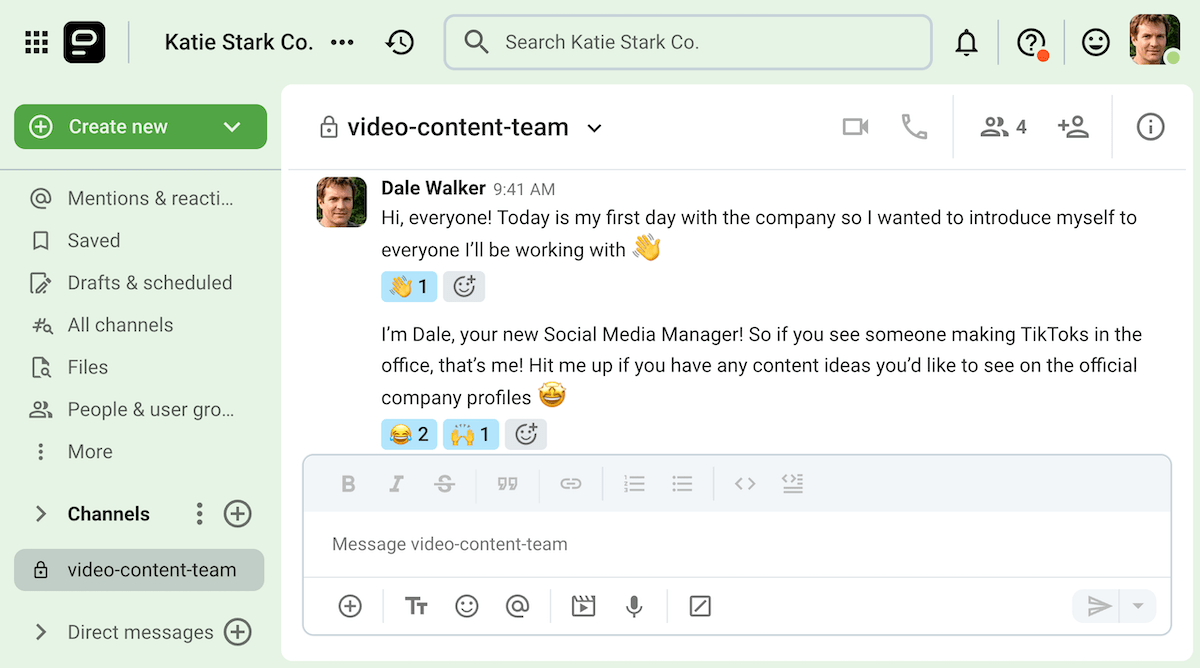
Dale’s self-introduction to his new team is easy to read and straight to the point, and:
- Has a warm and friendly tone,
- Introduces his role,
- Shows his personality, and
- Expresses his openness to collaboration.
Overall, it’s everything a first-day message should be.
How to introduce yourself professionally and ask for a favor from a coworker
If you want to ask a coworker you don’t know for a favor, you’ll need to introduce yourself first.
This makes a lot of people anxious, but it really doesn’t have to be as awkward as we make it out to be.
When asking for a helping hand:
- Briefly explain who you are and what your job responsibilities entail,
- Be clear about what you’re asking,
- Take into account your coworker’s current workload,
- Inform them of your request in advance,
- Choose a convenient time to schedule a meeting or send a message,
- Explain why you’re asking them for a favor,
- Accept rejection with grace in case they say “No”, and
- Thank them for their time.
If your coworker agrees to help, don’t forget to offer to return the favor down the line.
An example of how to introduce yourself to a coworker when you need to ask for a favor
When you reach out to a coworker, it’s essential to keep the message brief and polite.
Then, without beating around the bush, you should explain why you’re contacting them, just like in the below exchange.
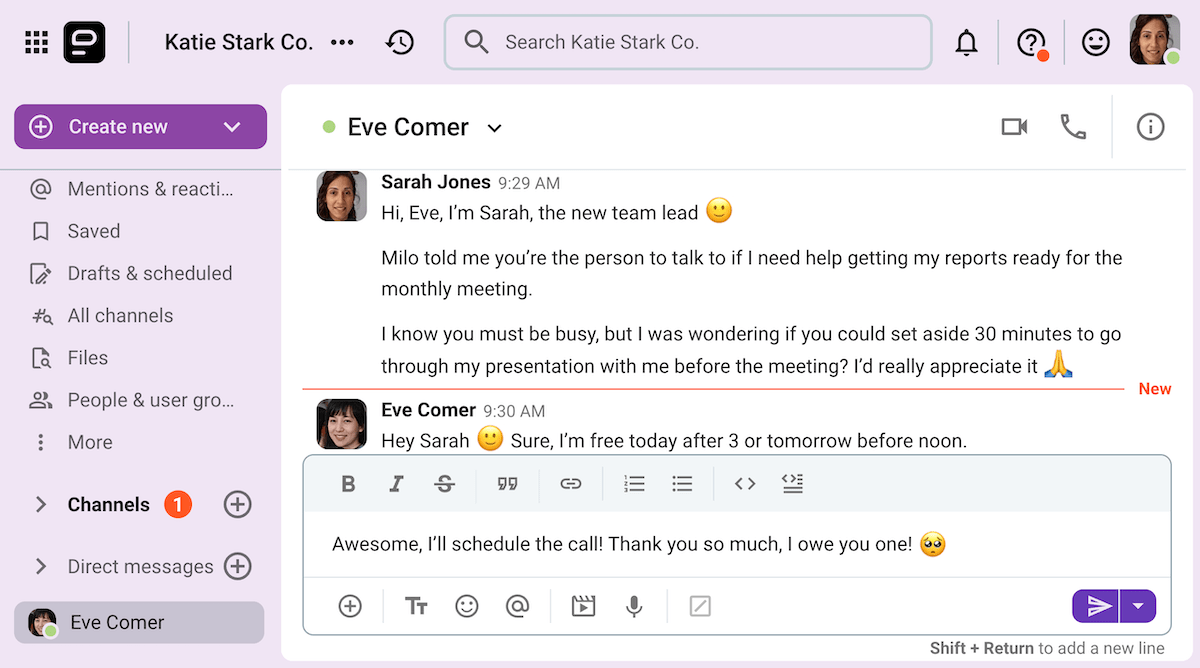
What NOT to do when you’re introducing yourself professionally
Now that you know how to introduce yourself professionally, let’s talk about some faux pas you should avoid when using the tips we’ve shared today.
When introducing yourself to business contacts, don’t:
- Use the same introduction in every situation. How you introduce yourself to your new manager will differ from how you greet a new coworker, right?
- Complain and be negative. Even if what you’re saying is true, there’s a time and place for everything, and you don’t want to be remembered as a Negative Nancy.
- Shy away from the spotlight. It’s normal to feel nervous when all eyes are on you, but don’t let your nerves get the better of you. Push through any shyness you may feel, and deliver an introduction that offers more than just your name and job title.
- Check your phone every couple of minutes. You may be doing it because you’re nervous, but it comes off as rude and shows disinterest in the person you’re talking to.
- Assume everyone comes from the same (cultural) context as you. This is especially true if you work in a multinational company or your network is multicultural. For example, grabbing someone’s hand and giving it a firm shake is perfectly acceptable in the West, but it would make a person from Japan uncomfortable — their handshakes are much softer.
- Get carried away. Rambling on about your background or accomplishments can put off potential customers or coworkers. Try practicing with a friend beforehand or jot down a quick outline to make sure your introduction strikes the right balance between personable and professional.
💡 PUMBLE PRO TIP
If you’re having trouble navigating cross-cultural communication in a business environment, check out our blog post:
Pumble lets you introduce yourself with style
You only get to make the first impression once — so, put effort into crafting the perfect, professional introduction.
If your team uses Pumble by CAKE.com to communicate and collaborate, you can easily introduce yourself to anyone at work — whether their workstation is several desks away from yours or on the other side of the planet.
Indeed, with Pumble, you can make a great first impression even before you decide to reach out to someone directly, by:
- Listing your job title in your Pumble user profile,
- Using a profile photo that shows off your personality,
- Putting emojis next to your name, if your company culture allows it, and
- Personalizing your status and availability.
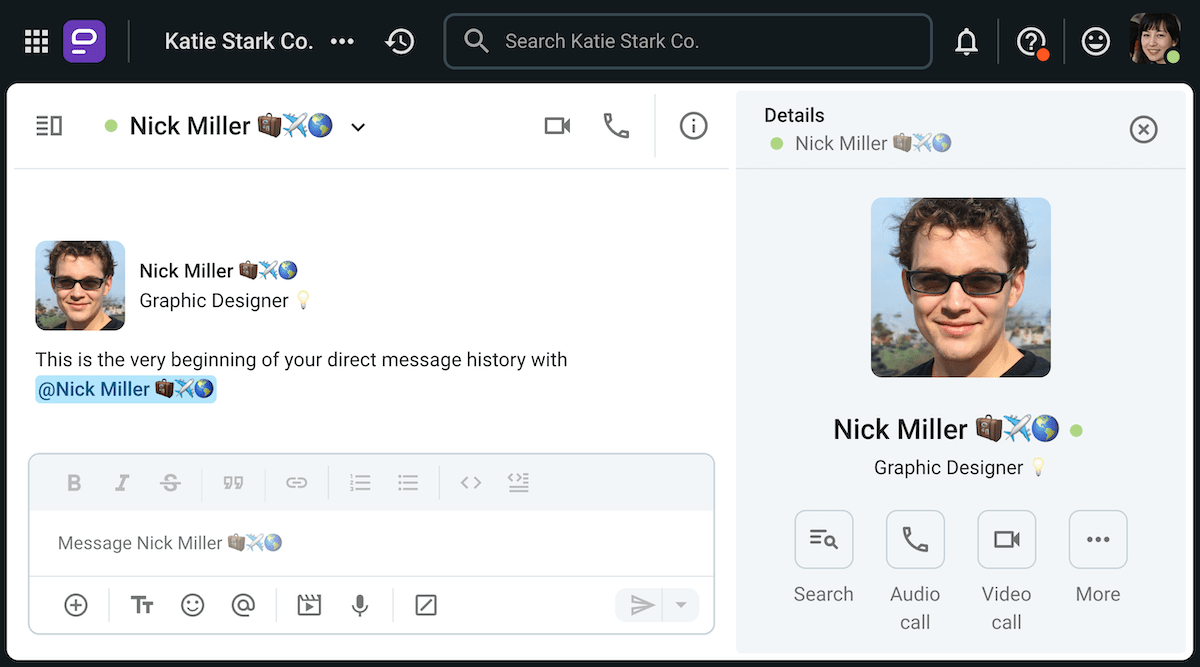
If you use the more relaxed channels on Pumble to post or respond to other people’s posts, your coworkers will be able to get a glimpse into your personality even before you officially introduce yourself to them.
But if your team prefers face-to-face communication, they can use Pumble to host video and audio calls, ideal for welcoming newcomers and making official introductions. Follow the tips and examples we’ve shared, and you won’t sell yourself short.
Make your first impression unforgettable.

